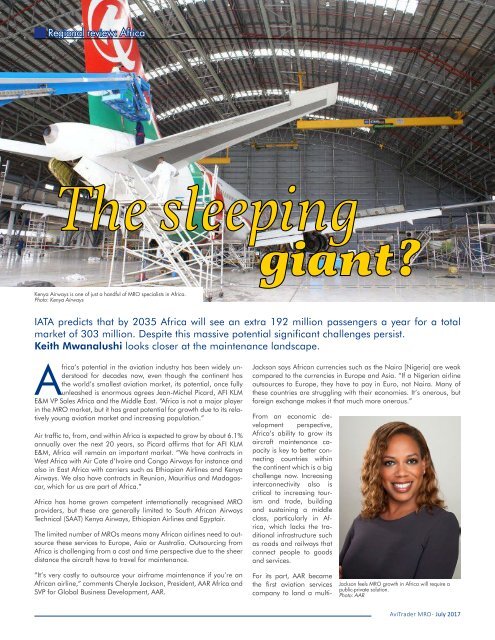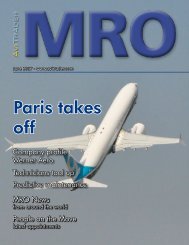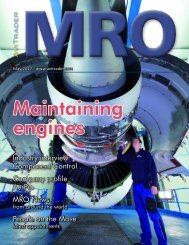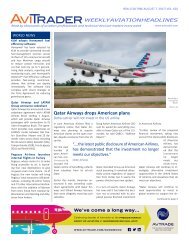2017-07 MRO Magazine
You also want an ePaper? Increase the reach of your titles
YUMPU automatically turns print PDFs into web optimized ePapers that Google loves.
Regional review: Africa<br />
12<br />
The sleeping<br />
giant?<br />
Kenya Airways is one of just a handful of <strong>MRO</strong> specialists in Africa.<br />
Photo: Kenya Airways<br />
IATA predicts that by 2035 Africa will see an extra 192 million passengers a year for a total<br />
market of 303 million. Despite this massive potential significant challenges persist.<br />
Keith Mwanalushi looks closer at the maintenance landscape.<br />
A<br />
frica’s potential in the aviation industry has been widely understood<br />
for decades now, even though the continent has<br />
the world’s smallest aviation market, its potential, once fully<br />
unleashed is enormous agrees Jean-Michel Picard, AFI KLM<br />
E&M VP Sales Africa and the Middle East. “Africa is not a major player<br />
in the <strong>MRO</strong> market, but it has great potential for growth due to its relatively<br />
young aviation market and increasing population.”<br />
Air traffic to, from, and within Africa is expected to grow by about 6.1%<br />
annually over the next 20 years, so Picard affirms that for AFI KLM<br />
E&M, Africa will remain an important market. “We have contracts in<br />
West Africa with Air Cote d’Ivoire and Congo Airways for instance and<br />
also in East Africa with carriers such as Ethiopian Airlines and Kenya<br />
Airways. We also have contracts in Reunion, Mauritius and Madagascar,<br />
which for us are part of Africa.”<br />
Africa has home grown competent internationally recognised <strong>MRO</strong><br />
providers, but these are generally limited to South African Airways<br />
Technical (SAAT) Kenya Airways, Ethiopian Airlines and Egyptair.<br />
The limited number of <strong>MRO</strong>s means many African airlines need to outsource<br />
these services to Europe, Asia or Australia. Outsourcing from<br />
Africa is challenging from a cost and time perspective due to the sheer<br />
distance the aircraft have to travel for maintenance.<br />
Jackson says African currencies such as the Naira [Nigeria] are weak<br />
compared to the currencies in Europe and Asia. “If a Nigerian airline<br />
outsources to Europe, they have to pay in Euro, not Naira. Many of<br />
these countries are struggling with their economies. It’s onerous, but<br />
foreign exchange makes it that much more onerous.”<br />
From an economic development<br />
perspective,<br />
Africa’s ability to grow its<br />
aircraft maintenance capacity<br />
is key to better connecting<br />
countries within<br />
the continent which is a big<br />
challenge now. Increasing<br />
interconnectivity also is<br />
critical to increasing tourism<br />
and trade, building<br />
and sustaining a middle<br />
class, particularly in Africa,<br />
which lacks the traditional<br />
infrastructure such<br />
as roads and railways that<br />
connect people to goods<br />
and services.<br />
“It’s very costly to outsource your airframe maintenance if you’re an<br />
African airline,” comments Cheryle Jackson, President, AAR Africa and<br />
SVP for Global Business Development, AAR.<br />
For its part, AAR became<br />
the first aviation services<br />
company to land a multi-<br />
Jackson feels <strong>MRO</strong> growth in Africa will require a<br />
public-private solution.<br />
Photo: AAR<br />
AviTrader <strong>MRO</strong> - July <strong>2017</strong>





